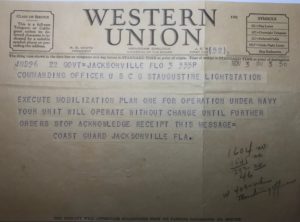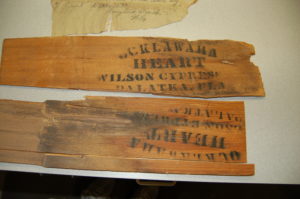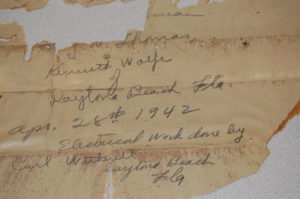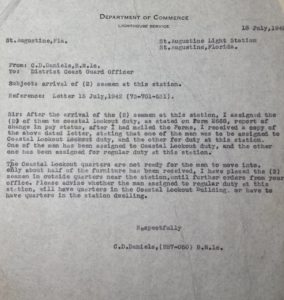The World War II-era United States Coast Guard (USCG) structure on site is currently being restored after serving as office space for many years at the Museum. The structure was constructed after the US entered into World War II. Before December 1941, the US military was in various stages of mobilization that included increasing military personnel, munitions and equipment.

The official telegram that head keeper Daniels received, which initiated a military mobilization plan that officially directed the US Navy to absorb the USCG (note that this occurs in November 1941 before the Pearl Harbor attack).
As war was declared, there was rapid action to train troops and prepare the US for overseas warfare. As the US prepared to enter into multiple war fronts, plans were developed and initiated for home front security. As part of this process, the USCG fell under direction of the US Navy. The Museum’s collections provide a glimpse into some of these rapidly developing events and the role the Lighthouse and Light Station played during the wartime effort. We are fortunate enough to have some of the original Keepers’ records here at the Museum.
After the attack on Pearl Harbor, military actions were intensified. Lighthouses along our coastline were immediately designated coastal lookouts serving to monitor boat traffic and identify any German U-boats in a region that would pose as an immediate threat. The US military forces, including the USCG, initiated routine patrol to guard our shorelines, albeit with limited resources. Coastal defense needed additional support and the USCG developed a series of infrastructure series of lookout towers strategically placed along the coastline. Additionally, a beach patrol was established on the coast with a combination of coastguardsmen: on foot with patrol dogs, on horseback and in some areas, in Jeeps. Training centers were established for this new defense effort and local infrastructure further grew to protect our coastlines from saboteurs and to help identify foreign invaders.
At our Lighthouse, the strategy was to construct a coastal lookout dwelling; it was finished and occupied in 1942. The dwelling (aka the Barracks) was built to house at least four coastguardsmen. Their job was to be on duty at the top of the tower 24/7, and report boat traffic (among other things) as part of the coastal defensive system. Unfortunately, there is limited documentation regarding this structure, but some information has been gleaned from past renovation projects as well as some of our original Keepers’ records. A Barracks reroofing project years ago produced a couple of fascinating finds. Among the layers of the former roofing projects, interesting details emerged surrounding construction activity at the Light Station. Original roof material was still present beneath a replacement metal roof. When this metal was removed, examples of original shingles were found! On the reverse side of these shingles was the name and location of the local manufacturer (nearby Palatka).

Shingles with manufacturer’s stamp.
The other amazing find was a section of roofing liner below the wood shingles with a portion of it signed by the individuals believed to have laid the roofing material, as well as the person who completed the electrical work. The fragments of paper are amazingly preserved and one can still clearly read the date of “April 28th 1942” for when the work was completed, and that the laborers were from Daytona Beach (possibly an indication of how busy it was in St. Augustine).

Fragment of paper showing the name and location of the laborers.
By the beginning of May, keeper correspondence suggests the structure is ready for occupation with mentions that the furniture has arrived (including a studio couch, for those who are curious). As staff has conducted searches in correspondence, we have previously been able to note some timeline issues or like most construction projects, a “delay” or “problem” during construction. For example, the coastal dwelling Keeper correspondence from August 1942 indicates the structure and wiring are complete, but additional work is required in order to connect to the main power line. We have also discovered that our first coastguardsmen reporting for lookout duty arrived in July 1942.

Letter from C.D. Daniels confirming arrival and subsequent assignment of coastguardsmen.
A copy of Keeper Daniels’ official report to superiors notes their arrival, and that yet again the dwelling is not quite ready for occupation. When we examine the roster of who arrives, one name is familiar to us: H.D. Defee. He is of interest to us because Defee’s name was previously found etched in concrete by the garage of the same time period. Interestingly, we know the concrete work was completed in 1944 so apparently he had at least a couple stints at the Lighthouse during the war. Restoration projects often reveal history that would not ever be found in any record. This is the case here at the Lighthouse. We suspect that as the restoration project continues, we are sure to find additional surprises!
Contributed by Chief Curator Jason Titcomb, edited by Student Intern Jayda Barnes

